Why Your Product Demo Isn’t Working, And How to Fix It?

Key Highlights:
|
In sales, a product demo can make or break a deal. Too often, demos focus on listing features rather than showing how those features solve real problems. This approach can quickly lose a prospect’s interest and leave them unengaged.
The challenge for sales teams is creating demos that speak directly to a potential customer's needs. Generic, one-size-fits-all demos often fall flat because they lack relevance. It’s frustrating to see a demo not land simply because it didn’t feel personalized.
A personalized demo changes the game. When you tailor a demo to address specific goals and pain points, it instantly becomes more compelling. This blog will show you how to craft impactful demos that connect, engage, and drive results.
What Defines A Great Product Demo?
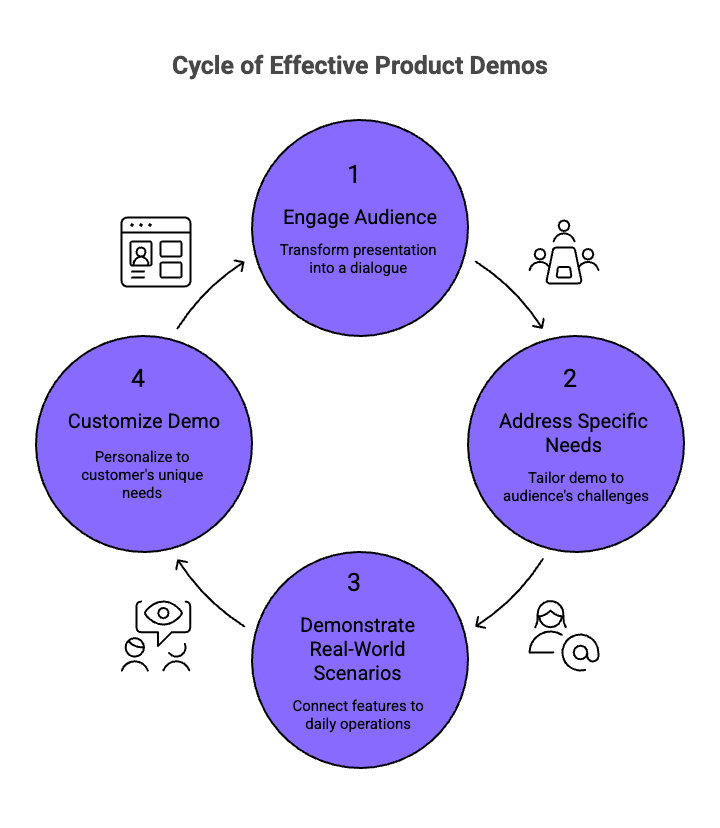
A great product demo goes beyond highlighting features; it shows how your product solves the prospect's problems and drives their success. It's about creating a tailored story that addresses their needs and encourages engagement.
Let’s explore what is product demos and how to create one that truly makes an impact.
1. Engaging the Audience
Engagement is the backbone of any successful demo. The key lies in transforming your presentation from a monologue to a dialogue. Instead of solely focusing on what to present, direct your attention to how to present in a way that captures the interest of your audience.
There are several ways you can boost audience engagement during a demo:
Ask probing questions to invite opinions and feedback.
Provide opportunities for interaction; for instance, allow your audience to try out your product in real time if possible.
Show a demo video that explains how the product works and its practical application.
Use storytelling techniques to resonate with your audience, ensuring the narrative is tied to their specific needs or challenges.
Blend in humor; it can loosen up the atmosphere, making the demo more enjoyable for everybody involved.
2. Addressing Specific Needs
Product demos should be tailored to the specific needs of your audience. Before a demo, do thorough research on their business, challenges, and goals. Use this information to focus on the product features that matter most to them.
The sales rep’s role is key here. By understanding the prospect’s challenges, the sales rep can show how the product not only solves current problems but also supports future growth.
Using data and research can make your case stronger, but adding empathy can make it more impactful. Showing you understand their concerns and want to help goes a long way in building trust.
3. Demonstrating Real-World Scenarios
Connecting your product’s features to real-life situations is a powerful demo strategy. By showing how your product can be used in their daily operations, you make its value clearer to potential customers.
An interactive demo that walks them through their tasks, showing how each feature fits into their workflow, can reinforce this message. Make sure every example you use relates to the problems they need to solve or the goals they want to achieve.
In the end, telling a story based on real-world scenarios helps your audience see how your product can help them succeed.
4. Standardized Vs. Customized Demo
Traditionally, companies used standardized demos to give a general overview of their product. While convenient, this "one-size-fits-all" approach often misses the mark because it doesn’t focus on the unique needs of each customer.
Now, many SaaS companies have moved to personalized demos that address specific customer needs. This approach involves gathering insights during discovery, understanding the prospect's pain points and goals, and highlighting the features that matter most to them.
A customized demo builds better connections with customers and boosts your chances of closing the deal. Next, let’s dive into the key elements that make a product demo truly effective.
What Makes a Product Demo Truly Great?
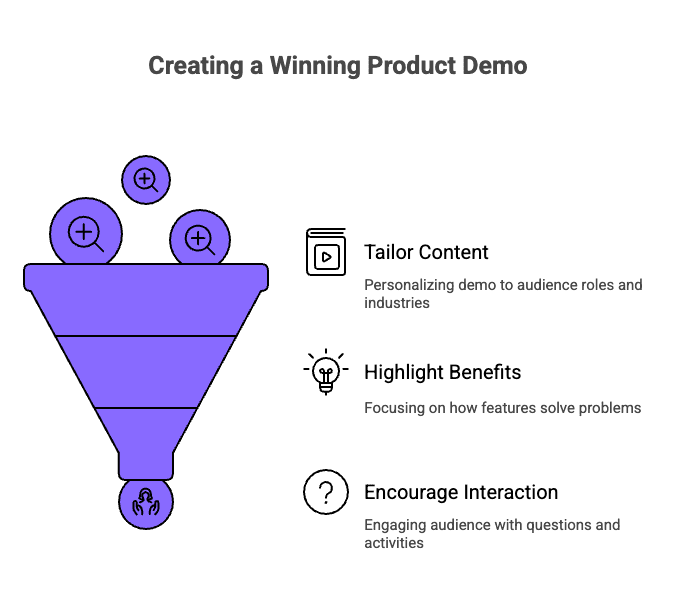
A winning product demo isn’t just a walkthrough; it’s a tailored, solution-driven experience that resonates with your audience. It captures attention, addresses real problems, and leaves prospects thinking, “This is exactly what we need.” Here's how to create a product demo video that nails every element:
1. Tailor the Demo to Your Audience
Personalization isn’t optional; it’s essential.
Start by understanding your prospect’s industry, role, and pain points. Use that insight to highlight the most relevant features and benefits. For instance, a CTO might want to see architecture and scalability, while a founder cares more about ROI and time to value.
Every aspect, language, feature selection, and use cases should reflect the customer’s world. Make them feel like your product was built for their exact needs.
2. Lead with Solutions, Not Features
Don’t just show what your product does. Show why it matters.
Prospects aren’t here for a feature list. They want to know: Will this solve my problem? Will it help me grow?
Tie each feature to a clear benefit: faster workflows, reduced manual work, better insights, and increased revenue. For example, don’t just demo a mass email tool; demonstrate how it cuts hours of work, personalizes outreach, and drives higher engagement across their funnel.
3. Drive Engagement Through Interaction
The more interactive your demo, the more it sticks.
Ask open-ended questions. Let prospects guide the flow. Create space for objections, feedback, and curiosity; it helps you learn what matters most.
Where possible, make the demo hands-on. Use simulations, clickable walkthroughs, polls, or mini-quizzes to make the experience feel active rather than passive. The more they engage, the more invested they’ll be.
How Do You Prepare For A Successful Demo?
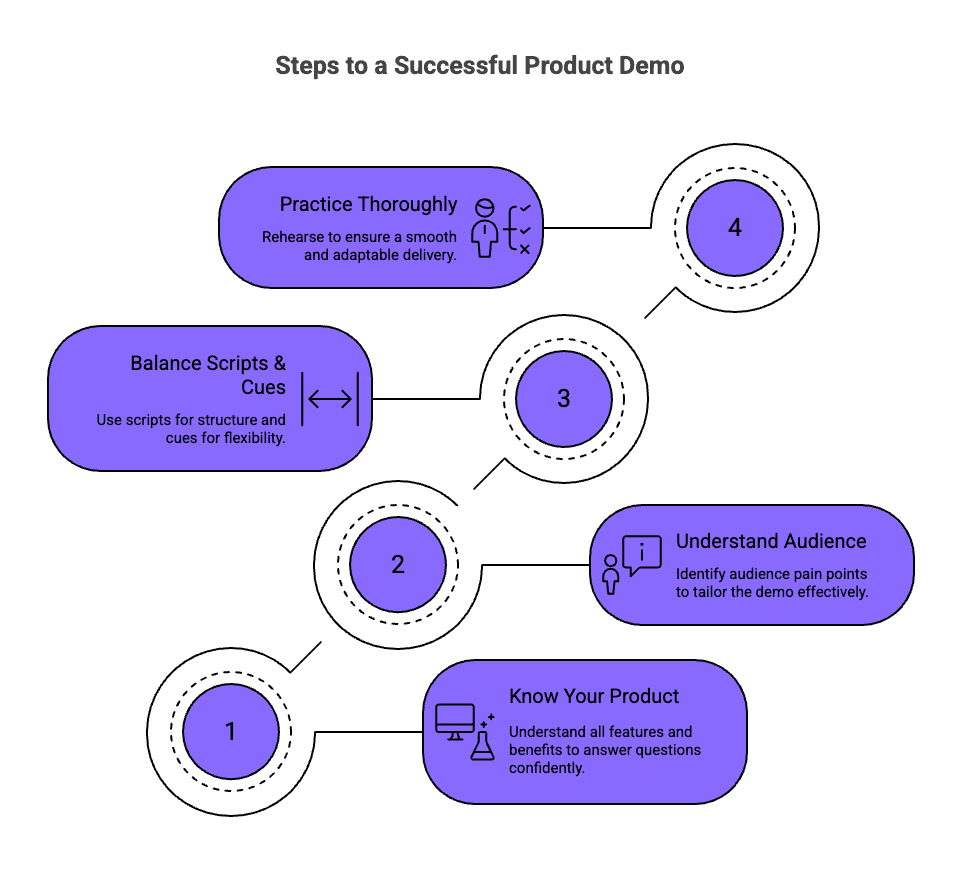
Effective preparation of a product demo includes meticulous planning and repeated rehearsal to ensure a smooth and adaptable delivery. Let’s explore the key elements to focus on how to do a product demo during your preparation.
1. Know Your Product Inside and Out
Knowing your product inside and out is crucial for a successful demo. It’s not just about understanding features but also about being able to confidently answer questions and show how the product solves real-world problems.
Being familiar with both the "how" and the "why" of each feature helps you explain its benefits clearly and convincingly to potential users and new users. Your idea-to-launch plan should also allow you to navigate the product smoothly during the demo, no matter what questions or scenarios come up. How well you present the product greatly impacts how it's perceived.
2. Understand Your Audience's Pain Points
Understanding your audience’s challenges is key to a powerful product demo. Prospects don’t want a general pitch; they want to know how your product can solve their specific problems and help them reach their goals.
Start by identifying their pain points during the discovery phase. Then, when preparing your demo, link each problem to a feature of your product that offers a solution. For example, if improving customer service is a pain point, show how your product speeds up response times and boosts customer satisfaction.
This personalized approach shows you truly understand their needs, building your credibility and making your demo more impactful.
3. Scripts Vs. Cues
In product demos, it’s important to understand the difference between scripts and cues. Scripts give you a structured outline, but they can sometimes sound stiff and rehearsed. Cues, on the other hand, offer more flexibility and help you interact naturally based on what’s happening in real time.
Using both can improve your demo. Stick to scripts for key points to keep things organized, but use cues to engage with your audience and adapt to their reactions. This balance helps you deliver a polished presentation while staying authentic and responsive.
4. Practice, Practice, Practice
The more you practice, the smoother your presentation will be, and you'll handle questions and objections more confidently. Run through your demo several times to get comfortable with the flow and content, ensuring you include a good story tailored for your target audience. Record your own video to spot areas for improvement, and pay attention to your tone, pace, and how clearly you explain features.
Practice with a colleague acting as your audience to get useful feedback. Be ready for unexpected issues like tech problems or tricky questions. The key is to stay calm and quickly get back on track without letting these hiccups disrupt your demo.
How Do You Deliver an Impactful Live Product Demo?
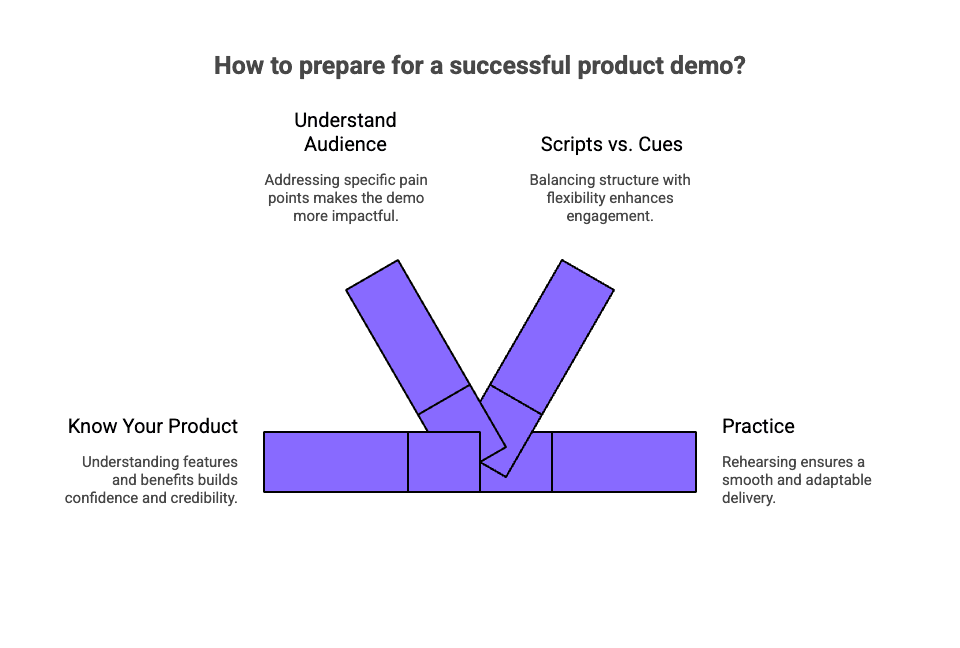
A great live demo isn’t just about pressing “share screen” and clicking through features. It’s about telling a story, showing value, and making your audience feel like your product was made for them. Here's how to make every demo count:
1. Start with a Story That Hits Home
People remember stories more than product specs.
Kick off your demo with a relatable scenario, one that mirrors your prospect’s daily struggles. Then walk them through how your product transforms that challenge into a win.
Think of it as a mini hero’s journey:
Here’s your problem…
Here’s what’s been getting in your way…
Here’s how our product clears the path…
And here’s the result you can expect.
Use simple language, draw parallels to real-world experiences, and let your product play the role of the “guide” in their success story.
2. Make It Look Effortless
No one wants a powerful tool that feels overwhelming.
Showcase how intuitive your product is. Walk through real use cases with minimal clicks. Emphasize how fast someone can go from “new user” to “getting results.”
If possible, let them try a live interactive demo themselves; it reinforces just how easy adoption can be.
3. Turn Objections into Opportunities
Questions and concerns? Good, they’re a sign your audience is engaged.
Welcome objections instead of dodging them. Ask clarifying questions to understand the root issue, then respond with clarity and confidence. Where possible, turn objections into proof points that reinforce your product’s strengths.
(“That’s a great point, here’s how we solved this exact issue for another customer…”)
4. Present Less. Converse More.
The best demos feel like collaborative problem-solving, not lectures.
Keep your delivery conversational. Pause often. Invite feedback. Ask open-ended questions to guide the discussion toward what matters most to them.
This two-way flow makes your demo more personalized, more engaging, and more likely to convert.
How Can You Improve Your Product Demos?
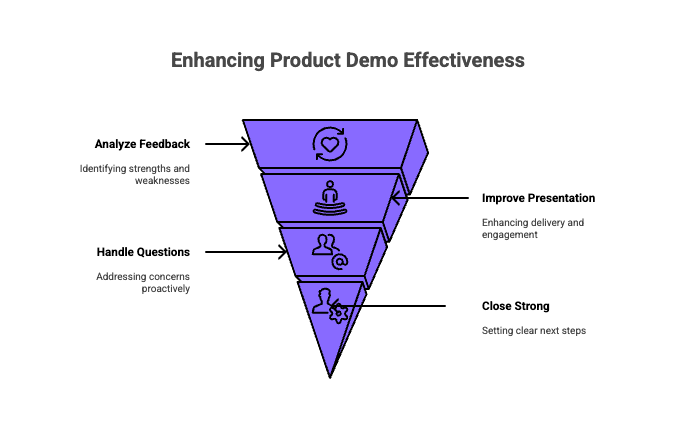
Great demos don’t just happen; they’re built, tested, and refined over time. If you want to close more deals and wow more prospects, you need to treat every demo as a learning opportunity. Here's how to level up:
1. Listen, Learn, and Adjust
Want to know what really works in your demos? Ask the people who just watched them.
Post-demo feedback is gold, whether it’s formal (surveys, follow-up calls) or informal (body language, questions asked, engagement cues). Ask what they loved, what felt unclear, and what they’d change.
Also, take five minutes after each session to reflect:
What got nods or smiles?
Where did you lose momentum?
What questions caught you off guard?
These small insights build up to big improvements over time.
2. Sharpen Your Presentation Skills
The way you deliver your demo matters as much as what you show. Even a great product can fall flat if it’s presented poorly.
Focus on:
Engagement – Keep the energy high and the audience involved
Clarity – Simplify technical details with relatable language
Pacing – Don’t rush; let key features land
Tone – Be confident, conversational, and curious
Practice regularly, review recordings, and treat each demo as a chance to improve your craft.
3. Handle Questions Smartly, And Finish Strong
The end of your demo shouldn’t feel like a dead-end; it should be a launchpad.
Rather than saving all questions for the end (and ending on a potential objection), weave them in throughout the demo. This keeps engagement high and lets you address concerns as they arise.
Then, close with a clear next step. Show your final slide, ask an open-ended question, and pause. Let the prospect lead the final part of the conversation. You’ll gain powerful insights and make follow-ups far more tailored and effective.
How to Create a Professional Product Demo Effortlessly with SmartCue?
SmartCue takes the hassle out of demo creation. Build professional, personalized product walkthroughs in minutes, not hours.
Whether you’re targeting top-of-funnel leads or late-stage prospects, SmartCue helps you simplify complex features, qualify leads faster, and improve close rates. It's built for speed, clarity, and conversion, so your team is always demo-ready and ROI-strong.
Not sure how SmartCue fits into your workflow? The best way to find out is to try it yourself, risk-free. Here's how you can create interactive demos that engage leads, shorten your sales cycle, and drive conversions in just a few minutes.
Step 1: Sign Up & Install the Chrome Extension

Get started with SmartCue’s free trial and set up your workspace in minutes.
Step 2: Capture & Build Your Demo
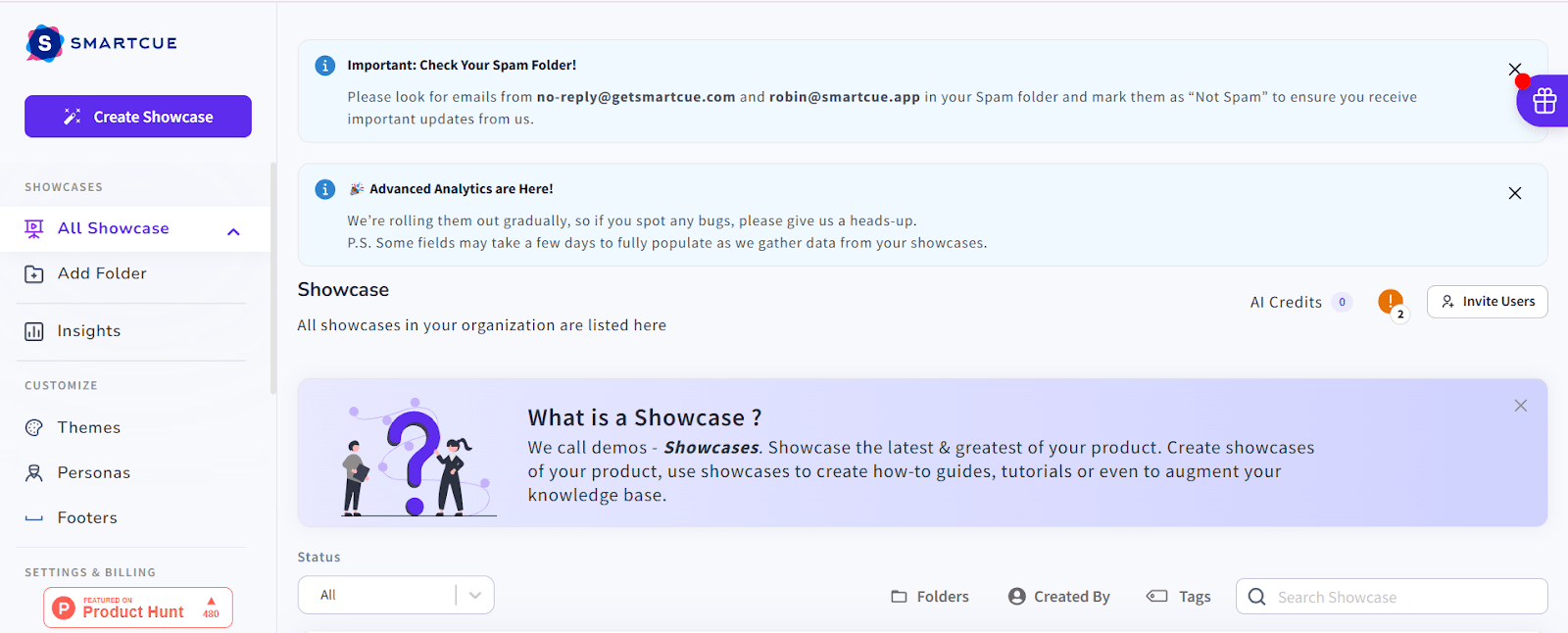
Use SmartCue to record your product walkthrough or start from a ready-made template.
Step 3: Customize for Clarity & Engagement
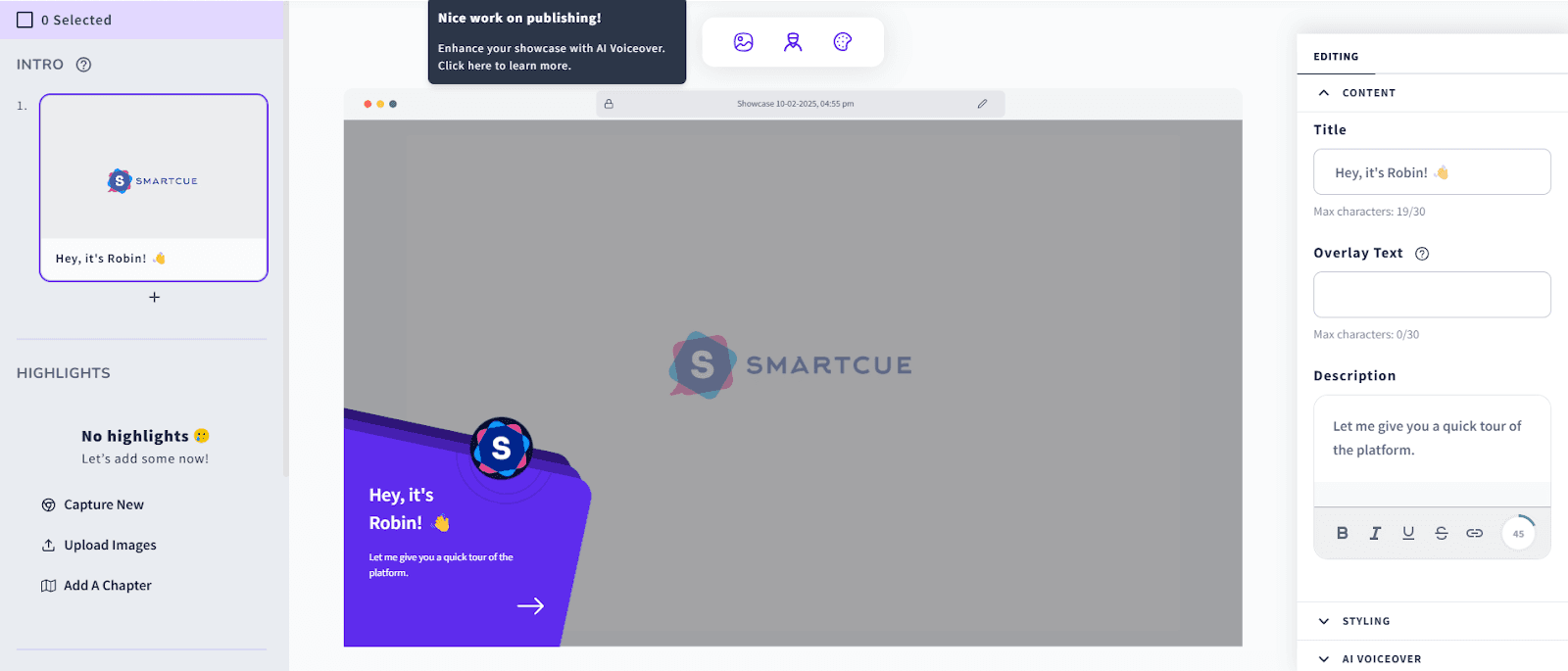
Add tooltips, text overlays, and interactive elements to guide prospects through your product’s value, without overwhelming them.
Step 4: Share & Track Engagement
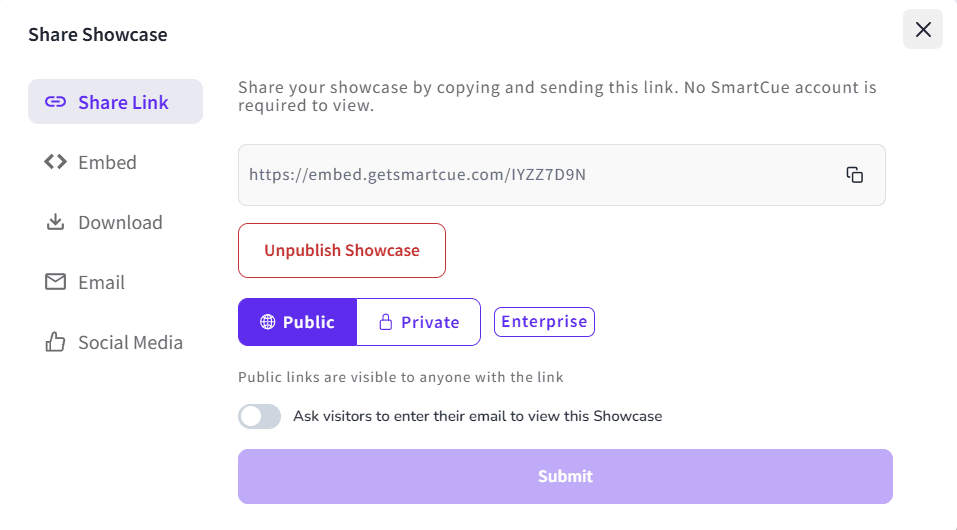
Send your demo link, then track which features prospects engage with the most, so you know exactly what resonates.
Try SmartCue Free for 14 Days – No Commitment
Frequently Asked Questions
What is a product demo, and why is it important?
A product demo is a walkthrough or presentation that highlights the core features and value proposition of your product. It plays a crucial role in the sales process by helping prospective customers see how your solution solves their specific pain points.
How do I create an effective product demo video?
To create a good product demo video, focus on clear messaging, strong visuals, and a format that highlights your product experience. Use a short demo video to explain key benefits and include a clear call to action to drive higher conversion rates.
What are the best tips for giving a successful live product demo?
A good demo should blend storytelling with functionality. Tailor the sales pitch to your audience, keep the demo format focused on solving their problems, and use interactive tools like a product tour to enhance the customer experience.
Can you share some examples of great product demos?
Great product demo examples include tools like Notion’s landing pages, Figma’s product demonstration videos, and Loom’s short demo video series on social media. These videos clearly explain the product while aligning with the buyer's stage in the sales funnel.
What steps should I follow to host a product demo for my SaaS product?
Start with a clear understanding of your audience and their specific pain points. Choose the right type of product demo (live, recorded, or interactive), script it around your value proposition, and showcase your core features with clarity and confidence.
How can I use AI tools to make interactive product demos?
AI tools like SmartCue, Storylane, or Navattic help you build interactive demos without code. These tools create a powerful way to engage leads by embedding product experiences directly into your marketing materials or knowledge base.
What are the common mistakes to avoid in a product demonstration?
Avoid feature-dumping, skipping the value of your product, or using a one-size-fits-all demo format. A good product demo video focuses on engagement, personalization, and addressing the audience’s concerns in real time.
Which free online tools can I use to create product demo videos?
Tools like Loom, Animoto, and Canva offer easy-to-use platforms for creating product demonstration videos. They're especially useful for producing short demo videos to embed on landing pages, blog posts, or share on social media.
How do product demos help increase sales conversions?
Effective product demos shorten the sales cycle by giving prospects a hands-on product experience early in the funnel. They help communicate the value of your product, answer objections, and ultimately close deals faster with higher conversion rates.
What basic script structure should I follow for a product demo?
Start with a quick intro, then address the prospect’s pain point. Move into the product tour, demonstrating how your tool solves that issue. Wrap with a clear call to action and options for next steps. This format works across types of product demos.
Comments
Your comment has been submitted successfully!